|
Leonard Streckfus
|
|
|
|
Biography
Leonard Streckfus was born in 1951 in Baltimore, Maryland. He earned BA and MA degrees in art history from the University of Maryland and an MFA from the Maryland Institute.
Picasso’s sculpture of animals created out of found materials has been an enduring inspiration for Streckfus. His creative process involves the search for suggestive shapes among heaps of thrownaway objects which he “weaves” together to make poetic images of animals in which a kind of Surrealist simultaneity exists between what was and what is.
Streckfus has an extensive exhibition record. Some highlights include his 2002 solo show at the Galleria Solaria Arte in Piacenza, Italy; his inclusion in “Trashformations (West)” in 1997 at the Whatcom Museum of Art in Bellingham, Washington and “Trashformations (East)” in 2005 at the Fuller Craft Museum in Brockton, Massachusetts, both curated by Lloyd Herman, Director Emeritus of the Renwick Gallery of the Smithsonian Institution. His work has been represented in two shows at the Lancaster Museum of Art (PA) in 1998 and 2004 curated by Cindi Morrison, and two shows at the Kentucky Derby Museum (1996, 1999) where he won the “Director’s Choice Award”. He had a solo show at the Galleria d’arte Il Salotto in Como, Italy (1989) and his work was selected for two Maryland Biennials at the Baltimore Museum of Art (1980, 1985), where he was awarded a prize by Martin Puryear. Additional solo shows include the Academy of the Arts in Easton, Maryland (1994); York College of Pennsylvania (1998); and Libreria Garzanti in Milan, Italy (1999). He was twice selected for the Smithsonian Craft Show in Washington, DC (2003, 2005); had a solo show at the Society for Contemporary Crafts in Pittsburgh, PA (1997) and the Arts Club in Washington, DC (2004) curated by Eric Denker. His work has been included in group shows at the Williamsburg Art Center in Brooklyn, New York (2002); the Art Works Gallery in Newark, Ohio (2003); the Greater Reston Arts Center (VA, 1997, 1998) curated by Jack Rasmussen; the Spruill Center for the Arts in Atlanta, Georgia (1998, 2000, 2001); and the Concorso Internazionale di Scultura in Arona, Italy (1996). In Baltimore, he has exhibited at the Galerie Francoise (1991, 1993, 2005); Paper Rock Scissors (2002); Maryland Art Place (2006, 2003); the Creative Alliance (2007); the George Ciscle Gallery (1986);and Steven Scott Gallery, Baltimore (1988-89) and Steven Scott Gallery, Owings Mills, MD (2007-08). His work was included in the inaugural show at MusMa, the Museum of Contemporary Sculpture in Matera, Italy (2006).
Public commissions include “Family of Dolphins” for the National Aquarium in Baltimore (1991); “Family of Wolves” for the Frederik Meijer Gardens and Sculpture Park in Grand Rapids, Michigan (2004); “Head Ski Column” for the Martha and Howard Head Theater at Center Stage in Baltimore (1992); and “Grazing Horse, Resting Hiker” for the Heritage Rail Trail in York County, PA (2001).
|
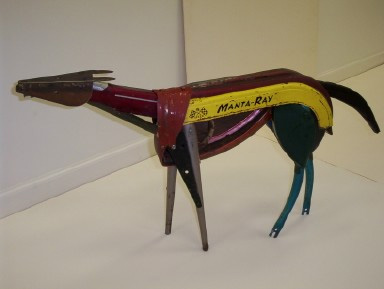
Hybrid 41 ("Thrasher"),
2007
found metal and wood assemblage--right view, 18 x 35 x 6",
$3200
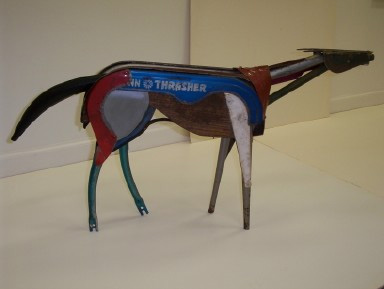
Hybrid 41 ("Thrasher"),
2007
found metal and wood assemblage--left view, 18 x 35 x 6",
$3200
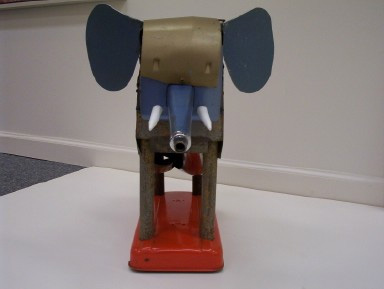
Elephant
2007
found metal, wood and plastic assemblage, 18 x 13 x 22"
$3200
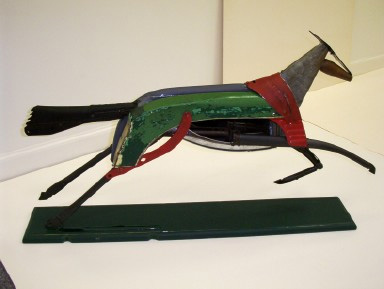
Hybrid 40 ("Bantam"),
2007
found metal and wood assemblage--left view, 19 x 35 x 6",
$3200
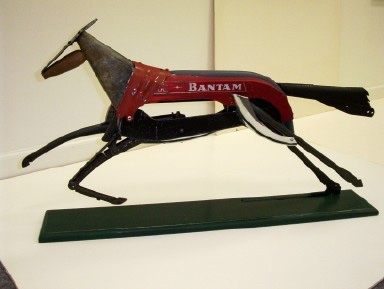
Hybrid 40 ("Bantam"),
2007
found metal and wood assemblage--right view, 19 x 35 x 6",
$3200
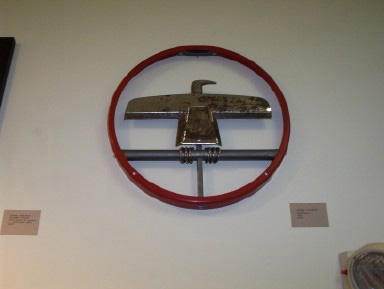
T-Bird,
2007
found metal assemblage, 15 1/2 x 15 1/2 x 2",
Private Collection
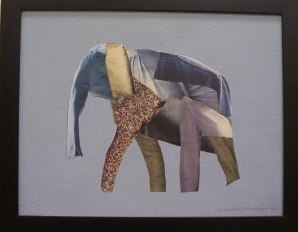
Elephant Collage,
2007
paper collage on painted watercolor paper, 16 1/4 x 20 1/4" framed,
$800
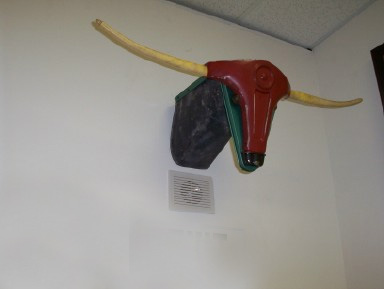
Steer Head,
2007
found metal and wood assemblage, 13 x 35 x 16",
$2500
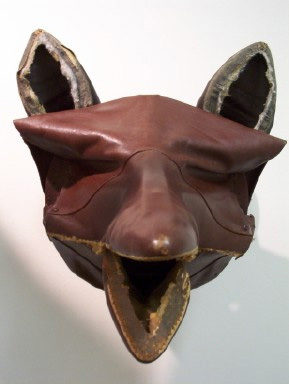
Fox Head,
2007
found leather, metal and wood assemblage, 14 x 14 x 16",
$2200
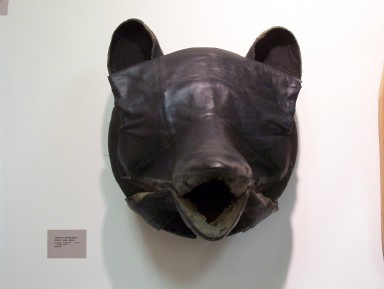
Black Bear Head,
2007
found leather, metal and wood assemblage, 17 x 14 x 14",
$2400
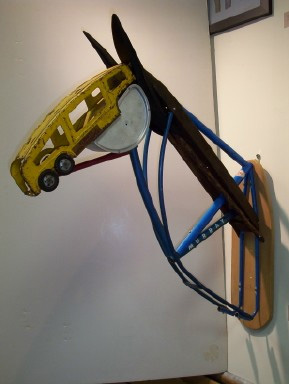
Horse Head,
2007
found metal, rubber and wood assemblage, 37 x 7 x 33",
$3000
|
|
Excerpts from critical essays:
Glenn McNatt in “The Sun”, Baltimore, MD (2005): “(Streckfus’s) works recall the ‘poor art’ materials of Italy’s ‘Arte Povera’ movement of the 1960’s, as well as the mix-and-match collages of earlier Cubist, Futurist and Constructivist artists, the ‘combine’ paintings of Robert Rauschenberg and the surreal box constructions of Joseph Cornell. All of them, like Streckfus, found a weird beauty in the cast-off artifacts of a society based on mass production and planned obsolescence. They discovered that when resurrected, such objects could be given new life as art.”
Luigi Sansone, in the catalog for “Leonard Streckfus: Lo Scultore del’Gran Ri’Fiuto” for his show at Solaria Arte in Piacenza, Italy (2002): "Streckfus’s uncanny knack of extrapolating life out of inanimate objects that are otherwise considered mere trash, of turning them into the living components of his creations, is a sort of working proof of the ancient philosophical principle of Parmenides, that ‘Nothing is created, nothing destroyed.’ Similarly, worth comparing is the work of another American artist Richard Stankiewicz whose sculpture-figures exclusively employed rusted metal culled from scrap heaps. In Streckfus as in Stankiewicz the myth of life begins with the death of the object.”
Salvatore Scarpitta, artist (2002): “Leonard’s sculptures are glyphs, letters of his life’s alphabet, signaling the density of the ecological as well as the survival of the imaginary not directed at becoming a roster of creatures but addressing the instrument where the wild and yet imagined exist.”
Eugenio Gazzola in “Liberta’”, Piacenza, Italy (2002) translated from the Italian by Ellen Burchenal: “(Streckfus’s) ability is not so much to make an object that ‘was’ an image of something else – even if it is on this mimetic level that we, the public, evaluate it – as much as the individualization, the physical restitution of one of the forms that the object itself contains… Because it is about things, materials, given before a name is arranged – exactly as it happens for a crucible of molten metal. Understanding of the object is therefore comprehension of the multiplicity that is contained in it.”
|

|

